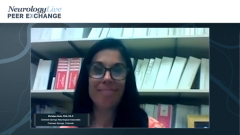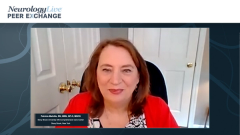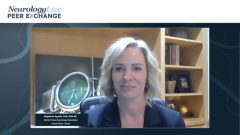
Clinical Experience Treating Relapsing MS With Cladribine
Best practices for treating patients with relapsing multiple sclerosis (MS) with cladribine, based on data revealed by clinical trials and experience in real-world practice.
Episodes in this series

Transcript:
Amy Perrin Ross, APN, MSN, CNRN, MSCN: I would like to ask anyone on the panel who is willing to chime in about any patient experiences that you had. This is a rather unique delivery. It’s an oral medication, but it’s a not a daily, once a day, or twice a day. It’s given in short bursts, and it’s given at year 1 and year 2. What, if anything, have you run into in terms of either people liking it and going on to that, or people being concerned about not getting treated every day?
Christen Kutz, PhD, PA-C: I don’t mind sharing some of my experiences. One of the things that I like about cladribine—in the ORACLE-MS trial, the inclusion age was between 18 and 66 years, whereas most of the clinical trials now usually stop at age 55. In my practice, I have about a quarter of patients over the age of 50, so it gives me some comfort knowing that this medicine was studied in older patients. Some of the niche patients that I have had success with is older patients who want to deescalate therapy. Maybe they are later on in age or having a discussion, “Can I stop what I am on?” This is a good last therapy for many patients. I also have some patients who travel. We’re a military town, so we have people that may be gone for long deployments, and this has been very convenient for patients who have those long travel times. I’ve had success in our noncompliant patients, patients in the past who I know struggle with taking a pill every day, or a pill twice a day, or making their infusion appointments, so this has been very effective in that patient population. Lastly, women thinking about pregnancy. If they complete their 2 treatment cycles, then wait 6 months, in most cases, their MS, is adequately treated and they’re safe to try to become pregnant.
Amy Perrin Ross, APN, MSN, CNRN, MSCN: It’s interesting that you talk about using this more as a deescalation strategy in your older patients. We do use it in older patients, but we also use it in younger people. This may be the first therapy that they are on because of the high efficacy that was demonstrated in the trials. Where you position it—in terms of your decision making—has as much to do with the drug and the mechanism of action as it does with the patient and what their disease burden is as you’re basing them. I use it in various scopes of practice, but you made some great points.
Stephanie Agrella, PhD, APN-BC: I was concerned in the beginning as well, before this became an option clinically, because of what you mentioned. I feared that patients would think that they were not being treated because there is not an ongoing regimen, but what I pleasantly found was that patients were adherent and had an improvement in their quality of life. What I mean by that is that they didn’t have to think about doing something every day, or every other day, or whatever. They did the regimen, and then it has this ongoing effect later, as we already know. I was pleased to see that, and I have not had anyone come to me and say it’s not working. I’ll just say that.
Amy Perrin Ross, APN, MSN, CNRN, MSCN: Christen brought up another good point, and that is the concept of adherence—are they taking the therapy or are they not? In my experience, with 2 short bursts, this is something that’s helpful to those folks as well. Part of it is how we position this drug and its mechanism of action, considering the patient’s current disease status.
Bryan Walker, MHS, PA-C: I agree with what everyone has said. I‘ve had a wide range of patients that I’ve had the pleasure of using this medication in—some younger patients and some older patients. There is a fair amount of flexibility with it. I’ve had patients who do extensive traveling, so it fits their lifestyle. I have patients who have an extreme phobia of needles, and they don’t want to even think about injecting themselves or going to an infusion center and having an IV [intravenous] stuck in them. There’s a wide range of patients that this medication could be appropriate for, but as the data shows, it is one of the higher efficacious medications. When you start to look at some of the subset analyses that have been done off these trials, it’s a relatively safe medication. If you look at things, such as absolute lymphocyte counts, and what that does, and whether we increase potential risk for infections in our younger patients and our older patients—since we do have more and more older patients—there was not a significant difference in rates of infection of those over and under 50. This is a medication that can be well positioned across many different patient types. I have not had anybody come back and say, “Oh my gosh, this is horrible,” or “I need to do something different.” I am encouraged. This is yet another tool in our toolbox that we’re able to offer our patients, not only from a novel mechanism of action standpoint, but also from the ease of administration standpoint and safety.
Amy Perrin Ross, APN, MSN, CNRN, MSCN: I agree.
Patricia Melville, RN, MSN, NP-C, MSCN: I want to echo what Bryan said. That’s an important point. It is an oral agent, but it does have the level of efficacy approaching that of the infusion therapies. That can’t be understated. That’s an important point. Because it doesn’t require consistent compliance, most patients can manage 4 or 5 days a month for 2 months. Those are 2 of the biggest advantages.
Amy Perrin Ross, APN, MSN, CNRN, MSCN: Another point is the concept of mechanism of action. Particularly in my older patient population, during the current pandemic, it’s made an indelible impression on our patients. What about infections? Maybe not just this one, but what about other infections? I use this time to discuss the mechanism of action, I reinforce the lymphocyte counts, what that means in terms of other infections, and what that means in terms of this drug. People sometimes find it more reassuring to move forward.
Thank you all so much. I would like to thank this wonderful panel, Christen Kutz, Stephanie Agrella, Bryan Walker, and Patricia Melville for this wonderful discussion. I’d like to thank you, as an audience, for watching NeurologyLive® Peer Exchange. If you enjoyed the content, I suggest that you subscribe to the NeurologyLive® newsletters to receive information about upcoming Peer Exchange segments and other content available to you. Thank you all so much.
Transcript edited for clarity.
Newsletter
Keep your finger on the pulse of neurology—subscribe to NeurologyLive for expert interviews, new data, and breakthrough treatment updates.



























